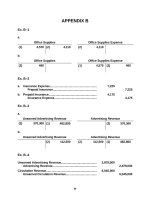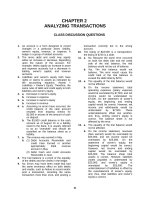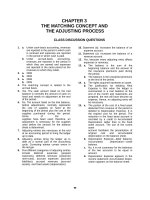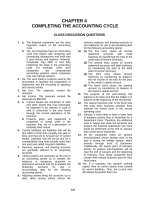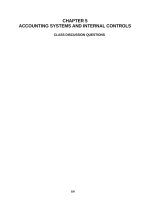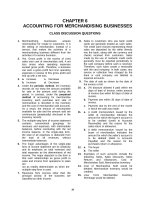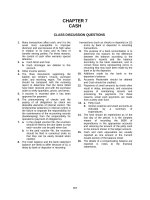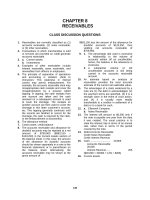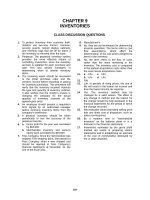Solution manual accounting 21e by warreni ch 05
Bạn đang xem bản rút gọn của tài liệu. Xem và tải ngay bản đầy đủ của tài liệu tại đây (291.16 KB, 65 trang )
CHAPTER 5
ACCOUNTING SYSTEMS AND INTERNAL CONTROLS
CLASS DISCUSSION QUESTIONS
229
1. The knowledge
that job rotation
is practiced and
that
one
employee may
perform
another’s job at
a later date
tends
to
discourage
deviations from
prescribed
procedures.
Also,
rotation
helps
to
disclose
any
irregularities
that may occur.
2. Authorizing
complete
control over a
sequence
of
related
operations by
one individual
presents
opportunities
for inefficiency,
errors,
and
fraud.
The
control over a
sequence
of
operations
should
be
divided so that
the work of
each employee
is automatically
checked
by
another
employee in the
normal course
of
work.
A
system
functioning in
this
manner
helps prevent
errors
and
inefficiency.
Fraud
is
unlikely without
collusion
between two or
more
employees.
3. To reduce the
possibility
of
errors
and
embezzlement,
the functions of
operations and
accounting
should
be
separated.
Thus,
one
employee
should not be
responsible for
handling cash
receipts
(operations)
and
maintaining the
accounts
receivable
records
(accounting).
4. No. Combining
the
responsibility
for
related
operations,
such
as
combining the
functions
of
purchasing,
receiving, and
storing
of
supplies,
increases
the
possibility
of
errors
and
fraud.
5. The
control
procedure
requiring
that
responsibility
for a sequence
of
related
operations be
divided among
different
persons
is
violated in this
situation. This
weakness
in
the
internal
control
may
permit
irregularities.
For
example,
the ticket seller,
while acting as
ticket
taker,
could
admit
friends without
a ticket.
6. The
responsibility
for maintaining
the accounting
records should
be
separated
from
the
responsibility
for operations
so
that
the
accounting
records
can
serve as an
independent
check
on
operations.
7. The individual
accounts
receivable
ledger accounts
provide
business
managers
information on
the status of
individual
customer
accounts,
which
is
necessary for
managing
collections.
Managers need
to know which
customers owe
money,
how
much they owe,
and how long
the
amount
owed has been
outstanding.
8. The
major
advantages of
the
use
of
special journals
are substantial
savings
in
record-keeping
expenses and a
reduction
of
230
record-keeping
errors.
9. a. 250
b. None
10. a. 250
b. 1
11. a. Sometime
following
the end of
the current
month, one
of
two
things may
happen: (1)
an overdue
notice will
be received
from
Hoffman
Co., and/or
(2) a letter
will
be
received
from Hoffer
Co.,
informing
the buyer of
the
overpayme
nt. (It is
also
possible
that
the
error will be
discovered
at the time
of making
payment if
the original
invoice
is
inspected
at the time
the check is
being
written.)
b. The
schedule of
accounts
payable
would not
agree with
the balance
of
the
accounts
c.
d.
12. a.
b.
payable
account.
The
error
might also
be
discovered
at the time
the invoice
is paid.
The
creditor will
call
the
attention of
the debtor
to
the
unpaid
balance of
$1,000.
The
error
will become
evident
during the
verification
process at
the end of
the month.
The
total
debits
in
the
purchases
journal will
be
less
than
the
total credits
by $2,000.
No,
the
error
will
not cause
the
trial
balance
totals to be
unequal.
No,
the
sum of the
balances in
the
creditors
ledger will
not agree
with
the
balance of
the
accounts
payable
account in
the general
ledger.
13. a. Cash
payments
journal
b. Purchases
journal
c. Cash
payments
journal
d. Purchases
journal
e. Cash
payments
journal
14. An
electronic
form
is
a
software
window
that
provides
the
inputs for a
particular
transaction. For
example,
a
check
form
provides
the
inputs (payee,
amount, date)
for
a
cash
payment
transaction. An
electronic
invoice
provides
the
inputs
(customer,
amount
sold,
item sold) for
recording
revenues
earned
on
account.
15. The
use
of
controlling
accounts
to
verify
the
accuracy
of
subsidiary
accounts
is
used
in
a
manual system.
In
a
computerized
system, it is
assumed that
the
computer
will accurately
sum
the
individual
transactions in
the subsidiary
accounts
in
determining the
aggregate
balance. Thus,
there
is
no
need
for
controlling
accounts
for
controlling the
accuracy of the
individual
postings.
16. For automated
systems
that
use electronic
forms
the
special journals
are not used to
record original
transactions.
Rather,
elec-
231
tronic forms capture
the
original
transaction
detail from an
invoice,
for
example, and
automatically
post
the
transaction
details to the
appropriate
ledger
accounts.
17. E-commerce
can be used by
a business to
conduct
transactions
directly
with
customers.
Thus, an order
can be received
directly
from
the customer’s
Internet
input
and cash can
be
received
from the credit
card.
Many
times, the cash
is received prior
to
actually
shipping
the
product,
resulting in a
faster
revenue/collecti
on
cycle.
Reducing
paperwork
throughout the
cycle
also
improves
the
efficiency of the
process.
For
example, all of
the accounting
transactions
can
be
fed
automatically
from the initial
Web-based
inputs.
EXERCISES
Ex. 5–1
a.
Agree. Barbara has made one employee responsible for the cash drawer in
accordance with the internal control principle of assignment of responsibility.
b. Disagree. It is commendable that Barbara has given the employee a specific
responsibility and is holding that employee accountable for it. However, after
the cashier has counted the cash, another employee (or perhaps Barbara)
should remove the cash register tape and compare the amount on the tape
with the cash in the drawer. Also, Barbara’s standard of no mistakes may
encourage the cashiers to overcharge a few customers in order to cover any
possible shortages in the cash drawer.
c. Disagree. Stealing is a serious issue. An employee who can justify taking a
box of tea bags can probably justify “borrowing” cash from the cash register.
Ex. 5–2
a.
The sales clerks could steal money by writing phony refunds and pocketing
the cash supposedly refunded to these fictitious customers.
b.
1.
Elegance by Elaine suffers from inadequate separation of
responsibilities for related operations since the clerks issue refunds and
restock all merchandise. In addition, there is a lack of proofs and
security measures since the supervisors authorize returns two hours
after they are issued.
2.
A store credit for any merchandise returned without a receipt would
reduce the possibility of theft of cash. In this case, a clerk could only
issue a phony store credit rather than taking money from the cash
register. A store credit is not as tempting as cash. In addition, sales
clerks could only use a few store credits to purchase merchandise for
themselves without management getting suspicious.
An advantage of issuing a store credit for returns without a receipt is
that the possibility of stealing cash is reduced. The store will also lose
less revenue if customers must choose other store merchandise instead
of getting a cash refund. The overall level of returns/exchanges may be
reduced, since customers will not return an acceptable gift simply
because they need cash more than the gift. The policy will also reduce
the “cash drain” during the weeks immediately following the holidays,
allowing Elegance by Elaine to keep more of its money earning interest
or to use that cash to purchase spring merchandise or pay creditors.
232
Ex. 5–2
3.
Concluded
A disadvantage of issuing a store credit for returns without a receipt is
that pre-holiday sales might drop as gift-givers realize that the return
policy has tightened. After the holidays, customers wishing to return
items for cash refunds may be frustrated when they learn the store
policy has changed. The ill will may reduce future sales. It may take
longer to explain the new policy and fill out the paperwork for a store
credit, lengthening lines at the return counter after the holidays. Sales
clerks will need to be trained to apply the new policy and write up a store
credit. Sales clerks also will need to be trained to handle the redemption
of the store credit on future merchandise purchases.
The potential for abuse in the cash refund system could be eliminated if
clerks were required to get a supervisor’s authorization for a refund
before giving the customer the cash. The supervisor should only
authorize the refund after seeing both the customer and the merchandise
that is being returned.
An alternative would be to use security measures that would detect a
sales clerk attempting to ring up a refund and remove cash when a
customer is not present at the sales desk. These security measures
could include cameras or additional security personnel discreetly
monitoring the sales desk.
Ex. 5–3
As an internal auditor, you would probably disagree with the change in policy.
First Charter has some normal business risk associated with default on bank
loans. One way to help minimize this is to carefully evaluate loan applications.
Large loans present greater risk in the event of default than do smaller loans.
Thus, it is reasonable to have more than one person involved in making the
decision to grant a large loan. In addition, loans should be granted on their
merits, not on the basis of favoritism or mere association with the bank president.
Allowing the bank president to have sole authority to grant large loans can lead to
the president granting loans to friends and business associates, without the
required due diligence. This can result in a bank becoming exposed to very poor
credit risks. Indeed, this scenario is one of the causes of savings and loan and
bank failures of the past.
233
Ex. 5–4
The Barings Bank fraud shows how small lapses in internal control can have huge
consequences. In this case, the “rogue trader” was able to accumulate and hide
huge losses. When the losses became so large that they could no longer be
hidden, it was too late. This fraud could have been avoided with a number of
internal controls. First, and most obvious, the execution and recording of trades
should have been separate duties. The trader makes the trades but should never
have access to accounting for them. In this way, the actual performance of the
trader could not be disguised by “fixing the books.” Second, the trader should be
under managerial oversight. For example, trades that exceed a certain amount of
exposure should require management approval. In this way, a trader would be
forced to slow down or stop once trades reached a certain limit. This would avoid
the trader’s tendency to try to “make up” losses with even larger bets. Third,
there should be no possibility for unauthorized accounts. All accounts should
require formal approval and be set up by individuals other than the trader. Once
the account is set up, the accounting should also be separated from the trader. In
this way, the trader would not be able to set up a “private” account that goes
undetected.
Ex. 5–5
This is an example of a fraud with significant collusion. Frauds that are
perpetrated with multiple parties in different positions of control make detecting
fraud more difficult. In this case, the fraud began with an employee responsible
for authorizing claim payments. This is a sensitive position because his decisions
would initiate payments. However, claims would need to be authorized and
verified before payment would be made. Knowing this, the employee made sure
each claim had a phony “victim.” Thus, there was a verifiable story behind each
claim. Only by tracking physical evidence of the accident could it be discovered
that the claim was fictitious. However, the very nature of the process was to
resolve small claims quickly without excessive control. Lastly, corrupt lawyers
were brought into the fraud to act as attorneys for the claimants. This gave the
claims even more credibility. In actuality, the lawyers had done legitimate
business with the trucking company, so all appeared normal. This fraud was
discovered when the fraudulent employee’s bank noticed irregularities in his
bank account and notified authorities. As the saying goes, “Follow the money!”
As a side note, the corrupt claims administrator fell into this behavior due to
gambling problems.
234
Ex. 5–6
Event Sound should not have relied on the unusual nature of the vendors and
delivery frequency to uncover this fraud. The purchase and payment cycle is one
of the most critical business cycles to control, because the potential for abuse is
so great. Purchases should be initiated by a requisition document. This
document should be countersigned by a superior so that two people agree as to
what is being purchased. The requisition should initiate a purchase order to a
vendor for goods or services. The vendor responds to the purchase order by
delivering the goods. The goods should be formally received using a receiving
document. An accounts payable clerk matches the requisition, purchase order,
and invoice before any payment is made. Such “triple matching” prevents
unauthorized requests and payments. In this case, the requests were
unauthorized, suggesting that the employee had sole authority to make a request.
Second, this employee had access to the invoices. This access allowed the
employee to change critical characteristics of the invoice to hide the true nature
of the goods being received. The invoice should have been delivered directly to
the accounts payable clerk to avoid corrupting the document. There apparently
was no receiving document (common for smaller companies); thus, only the
invoice provided proof of what was received and to be paid. If there had been a
receiving report, the invoice could not have been doctored and gone undetected,
because it would not have matched the receiving report.
Note to Instructors: This exercise is based on an actual fraud.
Ex. 5–7
a.
The most difficult frauds to detect are those that involve the senior
management of a company that is in a conspiracy to commit the fraud. The
senior managers have the power to access many parts of the accounting
system, while the normal separation of duties is subverted by involving many
people in the fraud. In addition, the authorization control is subverted
because most of the authorization power resides in the senior management.
b. Overall, this type of fraud can be stopped if there is strong oversight of senior
management, such as an audit committee of the board of directors. Individual
“whistle blowers” in the company can make their concerns known to the
independent or internal auditors who, in turn, can inform the audit committee.
The audit committee should be independent of management and have the
power to monitor the actions of management.
Ex. 5–8
1. General ledger accounts: (e)
2. Subsidiary ledger accounts: (a), (b), (c), (d)
235
Ex. 5–9
a., b., and c.
Accounts Receivable
Nov.
1
Bal.
480
Nov. 30
6,240
Nov. 30
Bal. 6,720
Envirolab
Nov.
1 Bal.
Nov. 27
Environmental Safety Co.
480
Nov.
1
2,625
965
Nov. 30 Bal. 2,625
Nov. 30 Bal. 1,445
Greenberg Co.
Nov. 10
Smith and Smith
1,050
Nov. 20
Nov. 30 Bal. 1,050
1,600
Nov. 30 Bal. 1,600
d.
DELTA CONSULTING CO.
Schedule of Accounts Receivable
November 30, 2006
Envirolab....................................................................................................
Environmental Safety Co..........................................................................
Greenberg Co............................................................................................
Smith and Smith........................................................................................
Total accounts receivable..................................................................
$1,445
2,625
1,050
1,600
$6,720
Ex. 5–10
a.
b.
c.
d.
e.
Cash receipts journal
Cash receipts journal
General journal (not a revenue transaction)
General journal
Cash receipts journal
236
f.
g.
h.
i.
j.
Cash receipts journal
Cash receipts journal
Revenue journal
Cash receipts journal
General journal
Ex. 5–11
a.
b.
c.
d.
e.
f.
g.
h.
i.
j.
Cash payments journal
Purchases journal
Cash payments journal
General journal
General journal
Cash payments journal
Purchases journal
Cash payments journal
General journal
General journal
k.
Purchases journal
Ex. 5–12
Nov.
3
9
13
Provided service on account; posted from revenue journal.
Granted allowance or corrected error related to sale of November 3;
posted from general journal.
Received cash for balance due; posted from cash receipts journal.
Ex. 5–13
Gold Coast Production Co.
Schedule of Accounts Receivable
April 30, 2006
Central States Broadcasting Co...............................................................
Korvette Co................................................................................................
Trask Co.....................................................................................................
Star Media..................................................................................................
Total accounts receivable..................................................................
$2,450
975
3,440
0
$6,865
Accounts Receivable
(Controlling)
Balance, April 1, 2006................................................................................
Total debits (from revenue journal)..........................................................
Total credits (from cash receipts journal)................................................
Balance, April 30, 2006..............................................................................
237
$ 4,670
16,165
(13,970)
$ 6,865
Ex. 5–14
REVENUE JOURNAL
Invoice
No.
Date
1
2006
Mar.
2
3
4
2
8
12
22
31
2
3
4
5
6
2006
Mar.
Conrad Co. ...........................
Orlando Co. ..........................
Drake Inc. .............................
Electronic Central, Inc. ........
Total.......................................
CASH RECEIPTS JOURNAL
Fees
Post. Earned
Account Credited
Ref.
Cr.
Date
1
512
513
514
515
Account Debited
PAGE 8
Post. Accounts Rec. Dr.
Ref.
Fees Earned Cr.
4
19
27
29
31
31
CMI, Inc. .....................
Drake Inc. ...................
Fees Earned................
Conrad Co. .................
Fees Earned................
Total............................
.............
.............
70
.............
40
110
Ex. 5–15
1. General ledger account: (c), (e), (h), (j), (k), (l)
2. Subsidiary ledger account: (a), (b), (d), (f), (g), (i)
3. No posting required: (m)
Ex. 5–16
1. General ledger account: (b), (c), (d), (f), (g), (i), (k), (l)
2. Subsidiary ledger account: (a), (e), (h)
3. No posting required: (j)
238
790
310
580
250
1,930
1
2
3
4
5
PAGE 12
Accts.
Rec.
Cr.
Cash
Dr.
240
530
.............
790
.............
1,560
240
530
70
790
40
1,670
1
2
3
4
5
6
Ex. 5–17
Feb.
6
10
16
Purchased services, supplies, equipment, or other commodities on
account; posted from purchases journal.
Received allowance or corrected error related to purchase of February 6;
posted from general journal.
Paid balance owed; posted from cash payments journal.
Ex. 5–18
Lasting Spring Landscaping
Schedule of Accounts Payable
June 30, 2007
Augusta Sod Co. ......................................................................................
Gibraltar Insurance Co. ............................................................................
Mayfield Lumber Co. ................................................................................
Owens Fertilizer.........................................................................................
Total accounts payable......................................................................
$ 7,340
1,100
3,140
0
$11,580
Accounts Payable
(Controlling)
Balance, June 1, 2007................................................................................
Total credits (from purchases journal).....................................................
Total debits (from cash payments journal)..............................................
Balance, June 30, 2007..............................................................................
239
$ 1,620
16,400
(6,440)
$11,580
Ex. 5–19
PAGE 36
PURCHASES JOURNAL
OTHER ACCOUNTS DR.
DATE
200
7
May
1
2
3
4
5
ACCOUNT CREDITED
3
12
17
20
31
Industrial Products, Inc.
Carver Paper Products, Inc.
Liquid Klean Supplies
Fountain Laundry Service
Total
POS
T
REF.
ACCOUNT
S PAYABLE
CR.
CLEANIN
G
SUPPLIES
DR.
85
205
170
70
530
ACCOUNT
1
2
4
5
6
7
2007
May 1
8
15
25
31
31
Check
No.
57
58
59
60
61
Account Debited
Liquid Klean Supplies......
Equipment.........................
Fountain Laundry Service
Industrial Products, Inc....
Salary Expense.................
Total...................................
Post.
Ref.
18
51
AMOUN
T
1
85
205
170
2
3
Laundry Service Exp.
460
CASH PAYMENTS JOURNAL
Date
POS
T
REF.
PAGE 41
Other
Accounts
Dr.
Accounts
Payable
Dr.
Cash
Cr.
.............
450
.............
.............
2,900
3,350
145
.............
115
85
.............
345
145
450
115
85
2,900
3,695
1
2
4
5
6
7
53
70
70
4
5
Ex. 5–20
a.
Two errors were made in balancing the accounts in the subsidiary ledger:
(1) The Martinez Mining Co. transaction of October 25 should have resulted
in a balance of $3,250 instead of $2,250.
(2) The Donnelly Minerals Inc. transaction of October 7 should have resulted
in a balance of $13,200 instead of $13,300, and the account balance at
October 31 should have been $7,400 instead of $7,500.
b.
MINERAL ASSAY SERVICES INC.
Schedule of Accounts Payable
October 31, 2006
Martinez Mining Co....................................................................................
Cutler and Powell......................................................................................
C. D. Greer and Son...................................................................................
Donnelly Minerals Inc................................................................................
Valley Power..............................................................................................
Total accounts payable......................................................................
Ex. 5–21
Revenue journal: (d), (i)
Cash receipts journal: (a), (e)
Purchases journal: (g), (h)
Cash payments journal: (b), (f)
General journal: (c), (j)
$ 3,250
9,100
13,750
7,400
3,150
$ 36,650
Ex. 5–22
1. The Cash column is for debits (not credits).
2. The Other Accounts column is for credits (not debits).
3. A better order of columns would be to place the Other Accounts Cr. column to
the left of the Fees Earned Cr. column.
A recommended and corrected cash receipts journal is as follows:
CASH RECEIPTS JOURNAL
DATE
ACCOUN
T
CREDITE
D
POST.
REF.
OTHER
ACCOUNT
S CR.
PAGE 12
FEES
EARNED
CR.
ACCOUNT
S REC. CR.
CASH
DR.
Ex. 5–23
a.
REVENUE JOURNAL
INVOICE
NO.
DATE
1
2
3
4
5
6
7
June 16
19
21
22
26
28
30
1
2
3
4
5
6
ACCOUNT DEBITED
A. Sommerfeld
K. Lee
J. Koss
D. Jeffries
J. Koss
K. Lee
POST.
REF.
8
PAGE 1
ACCTS.
REC.
DR.
FEES
EARNED
CR.
315
126
84
126
273
63
987
(12)
300
120
80
120
260
60
940
(41)
15
6
4
6
13
3
47
(22)
JOURNAL
Date
2006
June 24
Description
Office Supplies.......................................
Fees Earned.......................................
Sales Tax Payable..............................
SALES TAX
PAYABLE
CR.
1
2
3
4
5
6
7
8
PAGE 1
Post.
Ref.
14
41
22
Debit
Credit
168
160
8
Ex. 5–23
Continued
ACCOUNTS RECEIVABLE SUBSIDIARY LEDGER
D. Jeffries
Date
2006
June
Item
22 .............................................
Post.
Ref.
Dr.
Cr.
Balance
R1
126
.............
126
21 .............................................
26 .............................................
R1
R1
84
273
.............
.............
84
357
19 .............................................
28 .............................................
R1
R1
126
63
.............
.............
126
189
R1
315
.............
315
J. Koss
2006
June
K. Lee
2006
June
A. Sommerfeld
2006
June
16 .............................................
Ex. 5–23
Concluded
b.
GENERAL LEDGER
Accounts Receivable
Item
..........................................
R1
Date
2006
June 30
12
Post.
Ref.
Dr.
987
Cr.
..........
Balance
Dr.
Cr.
987
Office Supplies
2006
June 24
..........................................
14
J1
168
..........
168
Sales Tax Payable
2006
June 24
30
..........................................
..........................................
..........................................
..........................................
c. 1. $987 ($126 + $357 + $189 + $315)
2. $987
..........
22
J1
R1
..........
..........
8
47
..........
..........
Fees Earned
2006
June 24
30
..........
8
55
41
J1
R1
..........
..........
160
940
..........
..........
160
1,100
Ex. 5–24
a.
In the electronic invoice form from QuickBooks shown above, typical fields
for data input can be identified:
1. Customer name and address
2. Date and invoice number
3. Description of item sold
4. Amount of revenue
b. The customer accounts receivable is debited and Fees Earned is credited. A
computerized accounting system does not require posting to a separate
accounts receivable controlling account. In this case, the total accounts
receivable reported on the balance sheet is merely the sum of the balances of
the individual customer account balances.
Ex. 5–24
Concluded
c. Controlling accounts are not posted at the end of the month in a
computerized accounting system. In addition, special journals are not
normally used to accumulate transactions. Transactions are recorded through
data input into electronic forms (or for infrequent transactions, by an
electronic general journal). Balances of affected accounts are automatically
posted and updated from the information recorded on the form. If desired, the
computer can provide a printout of the monthly transaction history for a
particular account, which provides the same information as a journal. In
addition, the controlling account is not separately posted. In a manual
system, separate posting to the controlling account provides additional
control by reconciling the controlling account balance against the sum of the
individual customer account balances. However, in a computerized
accounting system there are no separate postings to a controlling account
because the computer is not going to make posting or mathematical errors.
Therefore, there is no need for the additional control provided by posting a
journal total to a controlling account.
PROBLEMS
Prob. 5–1A
1. and 2.
REVENUE JOURNAL
Invoice
No.
Date
1
2
3
4
5
6
7
8
2006
Aug. 18
20
22
27
28
30
31
31
1
2
3
4
5
6
7
Account Debited
Jacob Co...............................
Ro-Gain Co............................
Great Northern Co.................
Carson Co.............................
Bower Co...............................
Ro-Gain Co............................
Great Northern Co.................
PAGE 1
Post. Accounts Rec. Dr.
Ref.
Fees Earned Cr.
9
920
650
2,480
1,870
950
2,860
985
10,715
(12) (41)
JOURNAL
Date
2006
Aug. 28
1
2
3
4
5
6
7
8
9
PAGE 1
Description
Post.
Ref.
Supplies..................................................
Fees Earned.......................................
14
41
Debit
Credit
575
575
Prob. 5–1A
Continued
1.
ACCOUNTS RECEIVABLE LEDGER
Bower Co.
Date
2006
Aug.
Item
28 .............................................
Post.
Ref.
Dr.
Cr.
Balance
R1
950
.............
950
R1
1,870
.............
1,870
R1
R1
2,480
985
.............
.............
2,480
3,465
R1
920
.............
920
R1
R1
650
2,860
.............
.............
650
3,510
Carson Co.
2006
Aug.
27 .............................................
Great Northern Co.
2006
Aug.
22 .............................................
31 .............................................
Jacob Co.
2006
Aug.
18 .............................................
Ro-Gain Co.
2006
Aug.
20 .............................................
30 .............................................
Prob. 5–1A
Concluded
2.
GENERAL LEDGER
Accounts Receivable
Item
Dr.
Cr.
..........................................
R1
10,715
..........
Date
2006
Aug. 31
12
Post.
Ref.
Balance
Dr.
Cr.
10,715
Supplies
2006
Aug. 28
14
..........................................
J1
575
..........
575
Fees Earned
2006
Aug. 28
31
3.
..........
..........................................
..........................................
..........
41
J1
R1
..........
..........
575
10,715
..........
..........
575
11,290
a. $10,715 ($950 + $1,870 + $3,465 + $920 + $3,510)
b. $10,715
4. The single money column in the revenue journal can be replaced with three
columns for (1) Accounts Receivable Dr., (2) Fees Earned Cr., and (3) Sales
Tax Payable Cr.
Prob. 5–2A
1. and 5.
GENERAL LEDGER
Cash
11
Item
Post.
Ref.
Dr.
Cr.
Balance.............................
..........................................
CR36
..........
30,410
..........
..........
Date
2006
Nov.
1
30
Balance
Dr.
Cr.
18,940
49,350
Accounts Receivable
2006
Nov.
1
30
30
30
Balance.............................
..........................................
..........................................
..........................................
12
J1
R40
CR36
..........
..........
37,950
..........
..........
9,000
..........
25,860
15,320
6,320
44,270
18,410
Office Equipment
2006
Nov.
1
30
Balance.............................
..........................................
..........................................
..........................................
..........
..........
..........
..........
18
J1
..........
9,000
..........
..........
32,600
41,600
Fees Earned
2006
Nov. 30
30
..........
..........
..........
..........
41
R40
CR36
..........
..........
37,950
4,550
..........
..........
37,950
42,500
Prob. 5–2A
Continued
2. and 4.
ACCOUNTS RECEIVABLE SUBSIDIARY LEDGER
AGI Co.
Date
2006
Nov.
Item
1 Balance...............................
3 .............................................
23 .............................................
Post.
Ref.
Dr.
Cr.
Balance
.............
CR36 .............
R40
8,950
.............
12,340
.............
12,340
—
8,950
.............
R40
4,120
CR36 .............
R40
8,320
CR36 .............
.............
.............
2,980
.............
4,120
2,980
7,100
4,120
12,440
8,320
10,140
.............
.............
9,000
10,140
1,140
R40
6,420
CR36 .............
.............
6,420
6,420
—
Dover Co.
2006
Nov.
1
7
14
16
20
Balance...............................
.............................................
.............................................
.............................................
.............................................
Ross and Son
2006
Nov.
10 .............................................
30 .............................................
R40
J1
Yamura Co.
2006
Nov.
2 .............................................
19 .............................................
Prob. 5–2A
Concluded
3., 4., and 5.
REVENUE JOURNAL
Invoice
No.
Date
1
2006
Nov.
2
3
4
5
6
2
7
10
16
23
30
717
718
719
720
721
PAGE 40
Post. Accounts Rec. Dr.
Ref.
Fees Earned Cr.
Account Debited
Yamura Co.............................
Dover Co...............................
Ross and Son........................
Dover Co...............................
AGI Co...................................
6,420
4,120
10,140
8,320
8,950
37,950
(12) (41)
7
CASH RECEIPTS JOURNAL
Fees
Post. Earned
Account Credited
Ref.
Cr.
Date
1
2006
Nov.
2
3
4
5
6
3
14
19
20
30
30
AGI Co.........................
Dover Co.....................
Yamura Co..................
Dover Co.....................
Fees Earned................
7
.............
.............
.............
.............
4,550
4,550
(41)
2006
Nov. 30
Description
Office Equipment.........................................
Accounts Receivable—Ross and Son...
2
3
4
5
6
7
PAGE 36
Accts.
Rec.
Cr.
Cash
Dr.
12,340
2,980
6,420
4,120
.............
25,860
(12)
12,340
2,980
6,420
4,120
4,550
30,410
(11)
JOURNAL
Date
1
1
2
3
4
5
6
7
PAGE 1
Post.
Ref.
18
12/
Debit
Credit
9,000
9,000
The subsidiary account for Ross and Son must also be posted for a $9,000 credit.
6.
The subsidiary ledger is in agreement with the controlling account. Both have
balances of $18,410 ($8,950 + $8,320 + $1,140).
Prob. 5–3A
1. and 4.
GENERAL LEDGER
Field Supplies
Item
Dr.
Cr.
Balance.............................
..........................................
P30
..........
15,780
..........
..........
Date
2006
May
1
31
14
Post.
Ref.
Balance
Dr.
Cr.
5,300
21,080
Office Supplies
2006
May
1
31
Balance.............................
..........................................
15
P30
..........
1,380
..........
..........
1,230
2,610
Office Equipment
2006
May
1
19
Balance.............................
..........................................
1
31
Balance.............................
..........................................
..........
..........
18
P30
..........
6,500
..........
..........
18,400
24,900
Accounts Payable
2006
May
..........
..........
..........
..........
21
P30
..........
..........
..........
23,660
..........
..........
3,240
26,900
